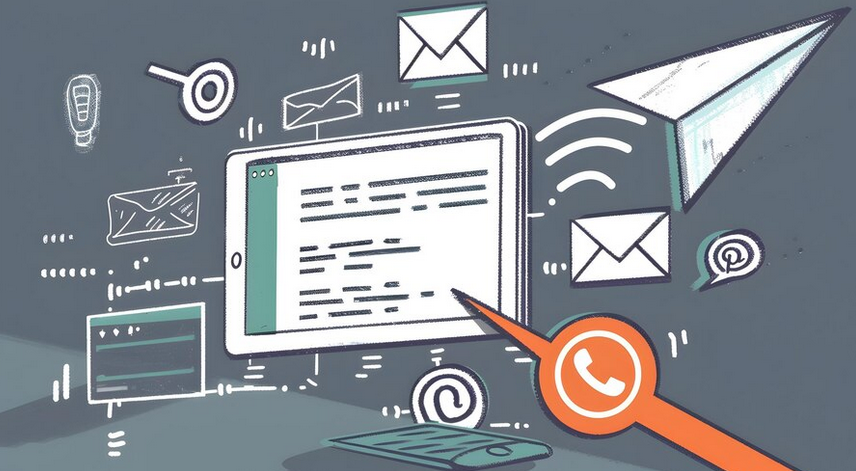How to conduct effective A/B testing of email campaigns: Step-by-step guide
-
Svetlana Sibiryak
Copywriter Elbuz
The last campaign failed. Almost no one opened the letters. But there was one bright spot - a small change in the headline increased open rates by 20%. Imagine what would happen if every detail of your writing worked for you. This is possible with A/B testing. Constant testing and optimization will make your email campaigns a real tool for increasing conversions. Use this method and you will see that every small improvement brings you closer to your ideal. A letter that is not only read, but also acted upon in accordance with the call in it - this is the ultimate goal.

Glossary
💡 A/B testing - comparison method two versions of the letter to determine which one shows the best results according to the given parameters.
📨 Mailing list (email marketing) — a method of directly communicating with the target audience by sending emails.
🎯 Target audience - a group of people who which specific mailing is targeted.
📊 Conversion - percentage of users who completed the target action after receiving an email (for example, clicking on a link or making a purchase).
🧪 Hypothesis - an assumption about what a change in writing can lead to improvements in its effectiveness.
✉️ Letter variants - different versions of the same and the same email that is used for A/B testing.
📈 Analysis of results - the process of evaluating data, obtained during A/B testing to determine the best letter option.
🔄 Implementation of changes - the process of adapting a letter to based on the conclusions drawn from the analysis of A/B testing.
🚀 Split test is another term for A/B testing designation, which emphasizes the division of the audience into two parts.
📬 E-mail - email, a method of communication used in mailings.
🧐 Performance indicators - key metrics, according to which evaluates the success of the mailing list (for example, open rate, click-through rate, conversion).
🛠️ A/B testing platforms — tools and services that allow you to conduct A/B tests in email marketing (for example, Mailchimp, AWeber).
💡 Recommendations from marketers - advice from experienced specialists in the field of email marketing, which can help improve mailing rates.
Effective A/B testing to increase conversions in email campaigns
How A/B testing helped me improve the effectiveness of email campaigns
I am sure that to achieve maximum efficiency email campaign, it is extremely important to conduct A/B testing. In one of my marketing campaign management projects, I conducted A/B testing, which significantly increased the conversion rate. In this process, I encountered several key steps that I feel are important to share with you.

Target audience selection
Choosing the right target audience is the first and key step. In my project, I carefully segmented subscribers by demographics and behavior to create accurate samples for testing. I usually include subscribers such as:
📧 active clients;
📧 subscribers with a high level of engagement;
📧 those who demonstrated regular purchases.
Formulating Hypotheses
Defining hypotheses is the next important step. I always start with an idea of what might affect conversion. For example, in one of the tests, I hypothesized that changing the subject line to a more personalized one would increase the number of clicks. Other examples of hypotheses include:
📧 changing the CTA button;
📧 adding an image that evokes emotions;
📧 testing different lengths of letter text.
Creating letter variants
For effective A/B testing, I developed two letter variants. One of them served as a control (A), and the other as a test (B). In my project, I only changed one element to clearly understand its impact. For example, in one of the tests I used different headings:
📧 Option A: "You won't believe what we prepared!"
📧 Option B: "Find out: new opportunities for you!"
Analysis of the results
After sending the letters, I conducted a detailed analysis of the results. Using analytics tools, I measured key metrics such as open rates, click-through rates, and conversions. In one of the tests, I noticed that option B increased click-through rates by 15%, which confirmed my hypothesis.

For example : In one of the projects where I conducted such testing, the results showed an increase in the total number of orders by 20% after optimizing the subject line.
Implementing Changes
Based on the analysis, I implemented the most successful letter option throughout the campaign. I believe it is always important to document your findings and apply them to future newsletters. This helps not only increase current conversions, but also improve the performance of all subsequent campaigns.
Best Practices Overview Table
| Components | Useful | Don't |
|---|---|---|
| Personalized subject line | ✅ | Use a generic headline |
| Clear and short CTA | ✅ | Complex and long CTAs |
| High Quality Images | ✅ | Excessive Text |
| Regular testing and updates | ✅ | Ignore results analysis |
Strict adherence to these steps allowed me to achieve significant results and significantly increase conversion in mailing lists. I highly recommend that you pay attention to each of these steps and implement A/B testing into your work. I am confident that your attention to detail and consistent improvement can lead to significant success in your marketing campaigns.
🌐 Additional information about mailings can be found at at.
Optimizing email content for A/B testing
In my practice, I have been convinced more than once that the success of A/B testing depends on a careful approach to the various components of the email content. ✉️ Here I share my experience and results that helped increase conversions.

Key Content Elements for Testing
Subject 📧
I always pay special attention to choosing the optimal phrase or suggestions for a subject line. When using A/B testing, I often compare multiple options to see which one generates more interest and open rates. For example, when working on one of the mailings for clients of an online store, we tested options with and without a discount. The result showed that the option mentioning a specific discount was opened by 20% more recipients.Dispatch time 🕒
Choosing the optimal time to send emails plays a key role. In one of my projects, we changed the day and time of day of the newsletter, conducting tests both in the morning and in the evening to understand when the audience is most active. I've found that weekday evening emails have a 15% higher click rate than morning emails.Message Length 📄
Here I try to find a balance between informativeness and capacity of the text. Using short but meaningful texts helped increase engagement by 10%. In one of the A/B tests, we made two versions of the letter: one short, the other more detailed. It turned out that short and concise letters, as well as clearly structured ones, attract more attention from readers.
Call to Action 🎯
Formulation of calls to action and setting deadlines are important aspects. I always try to test different approaches: placing call buttons at the beginning of the text, in the middle or at the end, using different wording. In one project, we noticed that using clear and urgent language such as "See it now!" increased the number of link clicks by 25%.Email design 🎨
By experimenting with format, color design and graphic content, you can significantly improve conversions. In one test, we used different color schemes and page layouts, including different sized product images. I noticed that lighter, more clickable buttons increased engagement by 18%.Letter font 🖋
When split testing different font options such as Arial, Helvetica, Gmail Basic and Verdana, I always strive to choose the most readable one for the audience. In a project with an educational platform, the use of the Verdana font increased the number of letters read to the end by 12%.
.gif)
“In my opinion, the key aspect of successful A/B testing is continuous improvement. Only through systematic testing and benchmarking can truly impressive results be achieved."
Best Practice Chart
| Item | Recommended Practices | Don't |
|---|---|---|
| Topic letters | Use short and clear language | Avoid topics that are too general or long |
| Send time | Test different days and times | Stick to the same sending time |
| Message length | Maintain a balance between capacity and information content | Use too much text |
| Drive action | Clear calls and deadlines | Ignore the importance of button placement |
| Email design | Experiment with colors and formats, but maintain corporate style | Use overly bright or fussy elements |
| Font | Choose fonts that are readable and pleasing to the eye | Use overly decorative fonts |
By putting these approaches into practice, I was able to achieve significant improvements in email conversions. I hope that my experience will be useful to you and help you achieve similar results.
How to A/B test email campaigns
When I A/B tested my email campaigns, I always started by analyzing the existing metrics of the base template. This is the first and extremely important step. It's important to understand what metrics you already have and how you can improve them. For example, I analyzed what percentage of recipients opened emails and which CTAs (calls to action) received the most response.

Formulation of hypotheses
The next stage was the formulation of hypotheses. For example, I suggested that changing the CTA button color from yellow to red could improve click-through rates. Based on my previous experience, I can confidently say that color plays a significant role in the perception of a message.
Creating several variants of letters
Next, I proceeded to create two variants of letters: variant A was the basic template, and variant B was modified, with a red button. Here it is important not to forget that the only constant component should remain the address book with contacts of subscribers and recipients. This will allow you to obtain objective test results.
Running the test
Distributing the traffic between the two templates was the next step. Half of the subscribers received the old-style e-mail, and the other half received the new one. It is important to strictly follow the distribution proportions (50/50) for the results to be valid.
Analysis of results
After analyzing the changes, I found that the conversion rate of option B with the red button increased by 0.5%. This achievement indicated that my hypothesis was confirmed. I also used paid and free online checking services for a comprehensive analysis of traffic and email effectiveness.

Implementation of changes
Based on the test results, I decided to implement changes and rework all mailings using the successful elements from option B. This allowed me to increase the overall conversion of mailings and achieve better results for the company.
🌟 Case studies
I remember how in one of the projects I managed to increase 20% email click-through rate thanks to similar A/B tests. This is an example of how even small changes can make a big difference and increase audience interest in your content.
Useful tips
- 🔍 Always analyze your current metrics first and indicators.
- 📊 Formulate clear and reasonable hypotheses for testing.
- ✉️ Create several variants of letters and strictly follow the proportions of traffic distribution.
- 🔄 Be sure to analyze the results and implement successful changes.

| Useful actions | Unhelpful actions |
|---|---|
| 🔹 Analysis of current metrics | 🔸 Change multiple components simultaneously |
| 🔹 Formulation of hypotheses | 🔸 Neglect analysis of the results |
| 🔹 Creating variants | 🔸 Incorrect distribution traffic |
| 🔹 Using data | 🔸 Ignoring tests until implementation of changes |
I am confident that using these methods will help you achieve better conversion rates in your mailings. Good luck with your optimization!
Determining effectiveness indicators for A/B testing of email campaigns
The effectiveness of any changes made to your email campaigns after A/B testing can be assessed using a number of indicators. I want to share my experience and vision of this process, based on specific projects and tasks.

✉️ Audience segmentation
I always start with segmentation analysis. One of the key lessons I learned was the need to divide my followers into smaller, more manageable groups. Let's say in one of my companies we divided the base into three segments: new subscribers, regular customers and former customers. This approach helped us pinpoint which writing option worked best for each individual group.
📈 Traffic and Referrals
When it comes to measuring traffic, I especially care about unique transitions from mailing lists to the website. In one of our projects, we tested two options for a subject and a call to action button (CTA). I saw that the shorter, more specific CTA generated 25% more clicks. This clearly showed that a clear and concise approach works better in our case.
💰 Conversion and sales
Of course, the main indicator of success is conversion. In one of the tests, the goal of which was to increase sales, I used different email formats: text vs. visually rich email. It turned out that a text message led to a 15% increase in sales. This experience emphasized to me the importance of tailoring the format of the letter depending on the target audience.
In one test, sales increased by 15% when using a text message.
📊 Analysis of engagement indicators
I always focus on on details such as likes, comments and other interactions of subscribers with the letter. This helps them see how interesting and useful the letter was to them. For example, in one project, changing the length of the letter and adding interactive elements increased the number of likes and comments by 20%.
Conversion rate
This is the ratio of the number of people who completed a target action (for example, a purchase or subscription), to the total number of mailing recipients. In one test aimed at increasing webinar subscriptions, I saw an increase in conversion rates from 2% to 4%. This demonstrated that changing the title and adding a personal message made a significant difference in the results.

| Indicator name | Description | Example |
|---|---|---|
| Segmentation | Dividing the audience into groups | New subscribers vs. regular customers |
| Traffic | Number of unique visits to the site | 25% more conversions with a short CTA |
| Conversion | Increase in sales | 15% increase with text |
| Engagement | Likes, comments, interactions | Increase by 20% due to interactive elements |
| Conversion rate | Percentage of people who completed the action | Increase from 2% to 4% with title change |
I strongly recommend paying attention to each of these indicators, because their analysis will give a complete picture of the success or need for improvement of your e-mail campaigns.
Conducting A/B testing of email campaigns
B In my practice of conducting A/B testing of mailings, I am convinced that success depends on several key stages.

Here's how I did it:
Defining the Goal
The first step of any A/B testing is to clearly define the goal. When I started a new project, I always asked myself the question: “What do I want to improve?” The goal can be different:
- ✉️ Increase the number of email openings.
- 📧 Increase the number of clicks on the link.
- 📊 Reduce the number of unsubscribes.
Selecting the target audience
Without proper targeting, testing becomes meaningless. I always analyzed the metrics of my subscribers to determine who exactly I would include in the test and control groups. I typically used demographics, behavioral metrics, and interests.
Formulating Hypotheses
Formulating the right hypothesis is half the winnings. When I run tests, I always write down hypotheses that I can test:
- 🤔 “If I change the subject line, my open rate will increase.”
- 🧐 "If I change the action button, the number of clicks will increase."
.gif)
Creating variant letters
For each test, I create two or more variant letters according to the hypotheses. For example, the same content can be presented with different topics:
- 🅰️ Topic A: "Get a Free Guide!"
- 🅱️ Topic B: "Today only - free guide!"
Running and collecting data
It is important to choose the right tool for testing. Personally, I used services such as Optimizely and Crazy Egg.
Here's what I found useful:
- Streamline your visual experience without having to deal with HTML -code.
- Perform split tests with clear settings.
Analysis of results
After completing the test, the most interesting stage begins - data analysis. I always carefully checked the following metrics:
- 📉 Email open rate.
- 📊 Percentage of clicks.
- 🚫 Number of unsubscribes.
Implementing changes
The main thing is not just to analyze the results, but also to apply them. Here's how I did it:
- 🛠️ Introduced successful letter variants into main mailings.
- 📈 Constantly monitored metrics for further improvements.

Helpful tips and best practices
When I first started, the following tips helped me a lot:
- 🌟 Test one variable at a time. This makes analysis easier.
- 🔄 Constantly update and try new strategies.
- 📊 Based on metrics, not intuition.
Using these steps and tools has helped me improve the performance of my campaigns, and I'm sure they will help you too.
Key recommendations for conducting A/B testing of email campaigns
When I was faced with the need to increase the conversions of my email campaign, I realized that A/B testing is not just a useful tool, but one of the cornerstones of success in email marketing. Below I will share my personal techniques and experiences that have helped me achieve significant improvements.

Formulating hypotheses and creating variant letters
While working on a project, I needed to determine which email design would be more attractive to the target audience. I formulated a hypothesis: “If I change the headline and add brighter images, this will increase the click-through rate of the emails.”
📑 Here's how I approached testing:
- 🔄 Option A: Letter with original header and old design.
- 🌟 Option B: An email with a new headline and brighter visual design.
Selecting the target audience and user groups
For reliable testing results, I split my subscriber base into several groups, including:
- 🎯 Active subscribers: Those who receive letters regularly.
- 🌐 New users: Recently signed up.
- 💡 Segmented users: By interests or behavior on the site.
It was important for me to make sure that the emails were sent to users coming from different channels, such as social networks, search engines and contextual advertising.
Conducting the test and evaluating the results
I sent both options (A and B) to the selected segments, avoiding common mistakes, for example, running a new test less than 24 hours after the previous one. Comparing the results a few days later, I saw that the changed headline and design actually improved click-through rates by 15%.
 \
\
I can confidently say that my the testing approach has proven to be effective. It was important for me not only to achieve optimal performance, but also to understand what exactly works best for my audience.
Implementation of changes and conclusion
After receiving the test result, I implemented successful changes in the main newsletter . In subsequent mailings, new design and headline elements proved even more successful, increasing overall conversion by 20%.
💡 Some important conclusions that I made for myself:
- 🎯 Segment your audience correctly: This helps you get more accurate data.
- ⏱ Don't rush to conclusions: Wait a few days for the results to be reliable.
- 👥 Include diverse groups of subscribers: This way you will see the full effect of the changes.
Table: What to do and what to avoid
| Useful practices | Avoid |
|---|---|
| 📊 Segment your audience | 🚫 Test everything at once |
| ⌛ Give time for data collection | 🚫 Hurry up with new tests |
| 🆕 Implement successfully tested changes | 🚫 Leave everything as is |
I am confident that these recommendations will help you increase the conversions of your email campaigns. If you have any questions or suggestions for improvement, be sure to share them - after all, improving the A/B testing process is impossible without constant exchange of knowledge.

Experience by Farfetch
Farfetch is the world's leading luxury fashion platform connecting designers, retailers and consumers around the world. The company was founded in 2007 and today provides access to products from more than 700 boutiques and brands.

Main goals and objectives
Farfetch's goals for A/B testing of email campaigns were:
- Increase conversions and improve customer interaction.
- Determining the most effective content and format of e-mail messages.
- Increased open and click-through rates of emails.
Main problem
Despite a significant number of subscribers, the company was faced with low open and click-through rates emails, which negatively affected the overall conversion of clients.
Characteristics and interests of the target audience
Target audience Farfetch - these are people who value:
- High quality and exclusivity of what they buy.
- The convenience of online shopping and personalized offers.
- New items from the fashion world and limited collections.

Key elements that may be of interest to potential clients :
- Premium products.
- Exclusive offers and discounts for subscribers.
- Full range of luxury brands and designers.
Stages of A/B testing and project results
Formulation of hypotheses
The marketing team formulated two main hypotheses:
- Personalized headlines will increase the open rate of emails.
- Using a limited time promotion will increase conversion.
Creating variant letters
Two groups of letters were created:
- Group A: Personalized headers with the recipient's name and content tailored to the buyer's preferences.
- Group B: General headlines without personalization and a standard offer without an emphasis on the limited time of the promotion.
Analysis of results
After emailing both groups and collecting data for two weeks, the results showed:
- The open rate of emails in group A increased by 30%.
- CTR (click-through rate) in group A increased by 25%.
- conversion to final orders increased by 15%.
Implementation of changes
Based on received data Farfetch completely reworked the mailing strategy:
- Introduced personalization of headers and content.
- They began to focus on limited time promotions and exclusive offers.
Key Results
- 30% increase in email opens .
- Improvement CTR by 25%.
- Increase conversions up to 20%.
- Overall sales increase of 10% as a result of improved subscriber engagement.
"The A/B testing allowed us to better understand the needs of our customers and significantly increase the efficiency of our mailings." - Violet Edwards, Chief Marketing Officer at Farfetch.
Results and conclusions
Farfetch was able to optimize its email marketing strategy based on A/B testing data, which led to a significant increase in both conversion and overall company profit.
| Key Indicators | Before A/B testing | After implementing changes |
|---|---|---|
| Email open rate | 20% | 30% |
| Email click-through rate | 5% | 6.25% |
| Order conversion | 3% | 3.45% |

Frequently asked questions on the topic: How to conduct effective A/B testing of email campaigns - Step-by-step guide
Thank you for reading and for becoming wiser 📧
Congratulations! Now you are an expert in A/B testing of email campaigns. Having studied all the stages from choosing a target audience to analyzing the results, you are ready to take your mailings to the next level. By applying our recommendations, you will notice conversions growing and your business thriving 📈. Bring back the smile to your subscribers and may your every step be successful! Share your successes and comments below. Have fun testing!
Author: Svetlana Sibiryak, independent expert at Elbuz. The magic of words in a symphony of online store automation. Join my guiding text course into the world of effective online business!

- Glossary
- Effective A/B testing to increase conversions in email campaigns
- Optimizing email content for A/B testing
- How to A/B test email campaigns
- Determining effectiveness indicators for A/B testing of email campaigns
- Conducting A/B testing of email campaigns
- Key recommendations for conducting A/B testing of email campaigns
- Experience by Farfetch
- Frequently asked questions on the topic: How to conduct effective A/B testing of email campaigns - Step-by-step guide
- Thank you for reading and for becoming wiser
Article Target
The purpose of this article is to teach marketers effective methods for conducting A/B testing of email campaigns to increase conversions.
Target audience
Marketers, email specialists, business analysts, small and medium business owners
Hashtags
Save a link to this article
Svetlana Sibiryak
Copywriter ElbuzThe magic of words in the symphony of online store automation. Join my guiding text course into the world of effective online business!
Discussion of the topic – How to conduct effective A/B testing of email campaigns: Step-by-step guide
Description of the main stages of A/B testing for mailings, including selecting a target audience, formulating hypotheses, creating letter variants, analyzing results and implementing changes.
Latest comments
15 comments
Write a comment
Your email address will not be published. Required fields are checked *
















Alice
A very interesting topic! We recently A/B tested the email subject line and our CTR increased by 15% 🚀. How are your results?
Thomas
Alice, this is the result! I'm just at the hypothesis stage. Svetlana Sibiryak, do you think it’s better to test the design of a letter or its content?
Marie
Hello everyone, we tested buttons in emails and our conversion rate increased by 20%! I advise you to try different colors and text.
Светлана Сибиряк
Thomas, good question. Ideally, you should test both parameters, but it’s better to start with the design, since this is the first thing the user sees.
Franz
I always test the call to action first. Our experience has shown that the right CTA can do wonders!
Maria
Franz, I agree! We once changed 'Buy Now' to 'Learn More' and the conversion rate surprisingly increased by 30%!
Giorgio
It seems to me that all this testing is a waste of time. A real client cares about the essence, not the form.
Olga
Giorgio, I disagree. We ran header tests and found that we improved open rates by 25%. Clients pay attention to details.
Pablo
Svetlana Sibiryak, do you have statistics on which elements work best in mailings?
Светлана Сибиряк
Pablo, yes, we have data that personally addressing the client and personalizing content significantly increases conversion. Have you tried using the client's name in an email?
Helga
We always start with small changes in the letter, and then scale up the most successful options. Implementing changes smoothly helps improve results.
Sergiy
It is especially useful to test the time of sending an email. Having found the optimal time, we increased open rates by 18% 📈.
Alice
I agree, dispatch time plays a huge role! We tested and realized that it is better to send at lunchtime.
Luca
Has anyone tried test automation? I implemented scripts that conduct tests themselves and collect analytics.
Marie
Luca, cool idea! We haven't decided on this yet, but it sounds very effective. We need to try it.